The Temple of Augustus (Croatian: Augustov hram; ) is a well-preserved Roman temple in the city of Pula – Istria – Croatia. Dedicated to the first Roman emperor, Augustus. It was most likely built during the emperor’s lifetime at some point between 27 BC and his death in AD 14. Built on a podium with a tetrastyle prostyle porch of Corinthian columns. The dimensions are about 8 by 17.3 m (26 by 57 ft), and 14 m (46 ft) high.
The temple was part of a triad consisting of three temples. The Temple of Augustus stood at the left side of the central temple. The similar temple of the goddess Diana stood on the other side of the main temple. The larger central temple has not survived, for example. The whole back side of the Temple of Diana is still clearly visible due to its incorporation into the Communal Palace, built in 1296.
Under Byzantine rule, the temple was converted into a church. This Accounts for its survival to modern times, and was later used as a granary.
In the 16th century, Andrea Palladio included the description of the temple in his I quattro libri dell’architettura. This was a highly influential book on the principles of Classical architecture.
By the late 19th century, the temple stood at the corner of the marketplace of Pula and partly concealed by houses, “so that the visitor cannot obtain a view till he is close to it.”
Struck by a bomb during an Allied air raid in 1944 and almost totally destred, later reconstructed in 1947. Today used as a lapidarian to display items of Roman sculpture.

